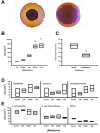Human Gut Bacteria Are Sensitive to Melatonin and Express Endogenous Circadian Rhythmicity
- PMID: 26751389
- PMCID: PMC4709092
- DOI: 10.1371/journal.pone.0146643
Human Gut Bacteria Are Sensitive to Melatonin and Express Endogenous Circadian Rhythmicity
Abstract
Circadian rhythms are fundamental properties of most eukaryotes, but evidence of biological clocks that drive these rhythms in prokaryotes has been restricted to Cyanobacteria. In vertebrates, the gastrointestinal system expresses circadian patterns of gene expression, motility and secretion in vivo and in vitro, and recent studies suggest that the enteric microbiome is regulated by the host's circadian clock. However, it is not clear how the host's clock regulates the microbiome. Here, we demonstrate at least one species of commensal bacterium from the human gastrointestinal system, Enterobacter aerogenes, is sensitive to the neurohormone melatonin, which is secreted into the gastrointestinal lumen, and expresses circadian patterns of swarming and motility. Melatonin specifically increases the magnitude of swarming in cultures of E. aerogenes, but not in Escherichia coli or Klebsiella pneumoniae. The swarming appears to occur daily, and transformation of E. aerogenes with a flagellar motor-protein driven lux plasmid confirms a temperature-compensated circadian rhythm of luciferase activity, which is synchronized in the presence of melatonin. Altogether, these data demonstrate a circadian clock in a non-cyanobacterial prokaryote and suggest the human circadian system may regulate its microbiome through the entrainment of bacterial clocks.
Conflict of interest statement
Figures




References
-
- Bell-Pedersen D, Cassone VM, Earnest DJ, Golden SS, Hardin PE, Thomas TL, et al. Circadian rhythms from multiple oscillators: lessons from diverse organisms. Nat Rev Genet [Internet]. 2005/06/14 ed. 2005. July [cited 2013 Jun 27];6(7):544–56. Available: http://www.ncbi.nlm.nih.gov/pubmed/15951747. Accessed 27 June 2013. - PMC - PubMed
-
- Johnson CH, Mori T, Xu Y. A cyanobacterial circadian clockwork. Curr Biol [Internet]. 2008. September 9 [cited 2015 Jan 29];18(17):R816–25. Available: http://www.pubmedcentral.nih.gov/articlerender.fcgi?artid=2585598&tool=p.... Accessed 29 January 2015. 10.1016/j.cub.2008.07.012 - DOI - PMC - PubMed
-
- Mackey SR, Golden SS, Ditty JL. The itty-bitty time machine genetics of the cyanobacterial circadian clock. Adv Genet [Internet]. 2011. January [cited 2015 Jan 29];74:13–53. Available: http://www.pubmedcentral.nih.gov/articlerender.fcgi?artid=3319097&tool=p.... Accessed 29 January 2015. 10.1016/B978-0-12-387690-4.00002-7 - DOI - PMC - PubMed
-
- Kitayama Y, Iwasaki H, Nishiwaki T, Kondo T. KaiB functions as an attenuator of KaiC phosphorylation in the cyanobacterial circadian clock system. EMBO J [Internet]. 2003. May 1 [cited 2015 Jan 8];22(9):2127–34. Available: http://www.pubmedcentral.nih.gov/articlerender.fcgi?artid=156084&tool=pm.... Accessed 8 January 2015. - PMC - PubMed
-
- Nakajima M, Imai K, Ito H, Nishiwaki T, Murayama Y, Iwasaki H, et al. Reconstitution of circadian oscillation of cyanobacterial KaiC phosphorylation in vitro. Science [Internet]. 2005. April 15 [cited 2015 Feb 25];308(5720):414–5. Available: http://www.ncbi.nlm.nih.gov/pubmed/15831759. Accessed 25 February 2015. - PubMed
Publication types
MeSH terms
Substances
Grants and funding
LinkOut - more resources
Full Text Sources
Other Literature Sources

